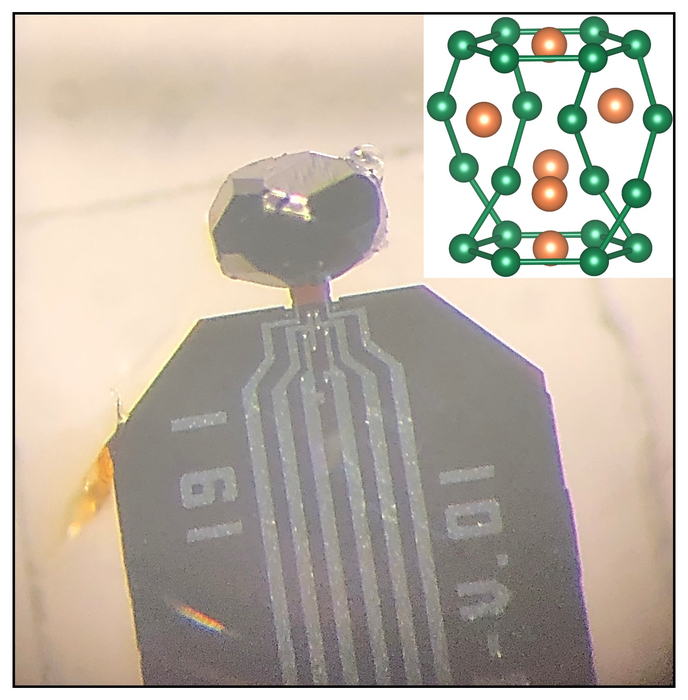Reviewed by Alex SmithSep 7 2021
In a new metallic specimen developed by a research group from Boston College, the motion of electrons tends to flow in the same way water flows in a pipe. Basically, this varies from particle-like to fluid-like dynamics.
 A small crystal of the new material, a synthesis of Niobium and Germanium (NbGe2), is mounted on a device to examine the behavior of the new electron-phonon liquid. The inset shows the atomic arrangement in the material. Image Credit: Fazel Tafti, Boston College.
A small crystal of the new material, a synthesis of Niobium and Germanium (NbGe2), is mounted on a device to examine the behavior of the new electron-phonon liquid. The inset shows the atomic arrangement in the material. Image Credit: Fazel Tafti, Boston College.
The researchers have reported their study in the Nature Communications journal.
Fazel Tafti, an Assistant Professor of Physics from Boston College collaborated with researchers from the University of Texas at Dallas and Florida State University (FSU) and discovered in the metal superconductor — a synthesis of Niobium and Germanium (NbGe2) — a powerful interaction between electrons and phonons that modifies the transport of electrons from the diffusive or particle-like, to hydrodynamic, or fluid-like, regime.
The study outcomes mark the first breakthrough in finding an electron-phonon liquid inside NbGe2, stated Tafti.
We wanted to test a recent prediction of the ‘electron-phonon fluid’. Typically, electrons are scattered by phonons which leads to the usual diffusive motion of electrons in metals. A new theory shows that when electrons strongly interact with phonons, they will form a united electron-phonon liquid. This novel liquid will flow inside the metal exactly in the same way as water flows in a pipe.
Fazel Tafti, Assistant Professor of Physics, Boston College
According to Tafti, phonons are nothing but the vibrations of a crystal structure.
On verifying the predictions of theoreticians, the experimental physicist Tafti — collaborating with his Boston College partner Professor of Physics Kenneth Burch, Luis Balicas of FSU and Julia Chan of UT-Dallas — states that the breakthrough will lead to the further exploration of the material and its possible applications.
According to Tafti, the daily lives of people rely on the flow of electrons in wires and water in pipes. Even though the two phenomena may sound quite similar, they are different. Water molecules tend to flow as a fluid continuum, not as separate molecules, thereby complying with the laws of hydrodynamics. Yet, electrons flow as individual particles and diffuse within metals as they get dispersed by lattice vibrations.
The researchers carried out an analysis with major contributions from Hung-Yu Yang, a graduate student researcher, who earned his doctorate from BC in 2021. He concentrated on the conduction of electricity in the new metal, called NbGe2, stated Tafti.
Three experimental methods were employed by the researchers: The first one was electrical resistivity measurements, which displayed a higher mass for electrons compared to what was expected; the second one was Raman scattering that revealed a change of behavior in the vibration of the NbGe2 crystal as a result of the unique flow of electrons; and the third one was X-ray diffraction, which disclosed the material’s crystal structure.
Tafti stated that the scientists discovered that the mass of electrons obtained in all trajectories was three times larger compared to the expected value. This could be found by employing a specific method called “quantum oscillations” to assess the mass of electrons in the material.
Tafti’s work was financially supported by the National Science Foundation.
This was truly surprising because we did not expect such ‘heavy electrons’ in a seemingly simple metal. Eventually, we understood that the strong electron-phonon interaction was responsible for the heavy electron behavior. Because electrons interact with lattice vibrations, or phonons, strongly, they are ‘dragged’ by the lattice and it appears as if they have gained mass and become heavy.
Fazel Tafti, Assistant Professor of Physics, Boston College
Tafti intends to identify other materials in this hydrodynamic regime by taking advantage of the electron-phonon interactions. Furthermore, his research group will concentrate on regulating the hydrodynamic fluid of electrons in these materials and designing new electronic devices.
Journal Reference:
Yang, H.-Y., et al. (2021) Evidence of a coupled electron-phonon liquid in NbGe2. Nature Communications. doi.org/10.1038/s41467-021-25547-x.